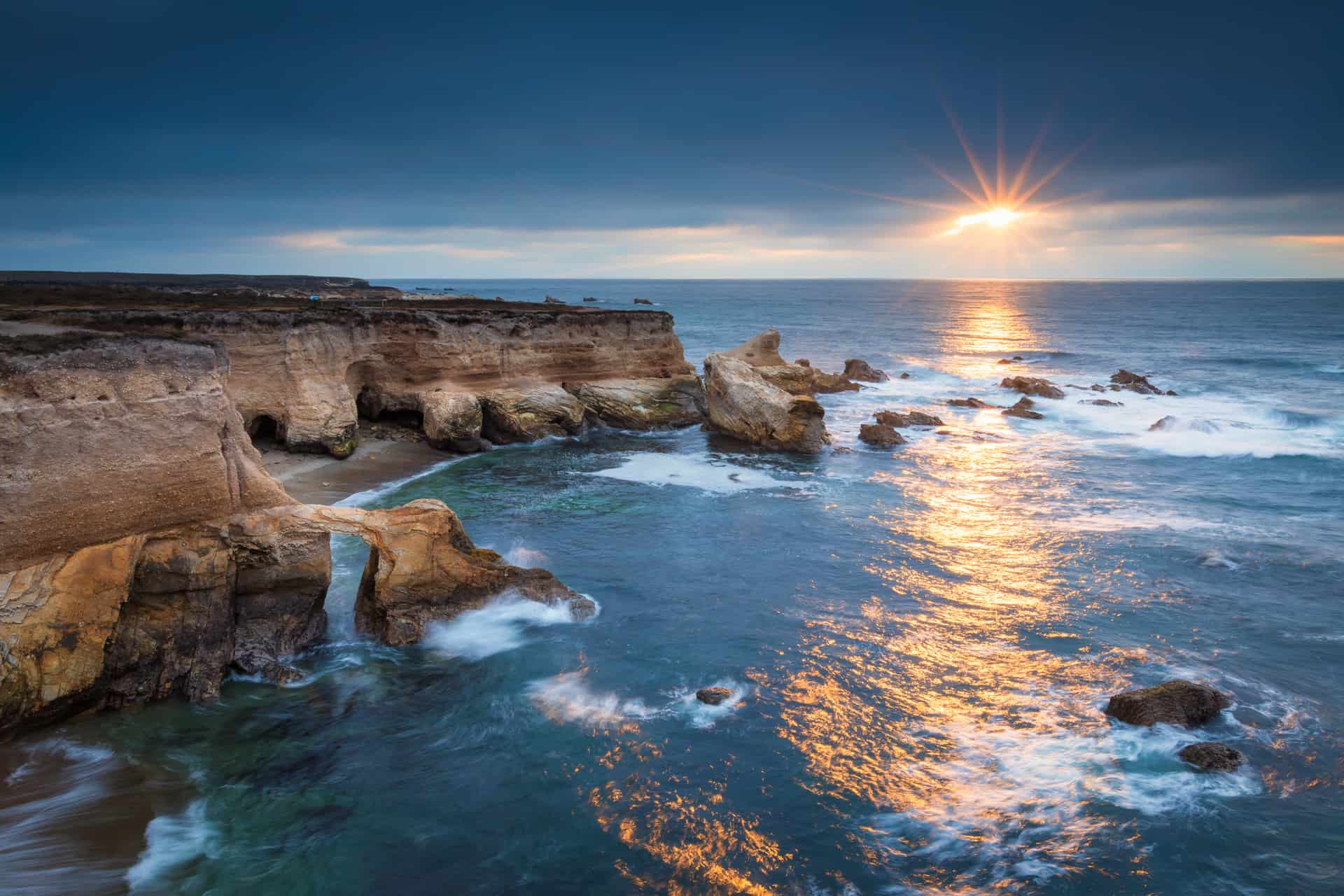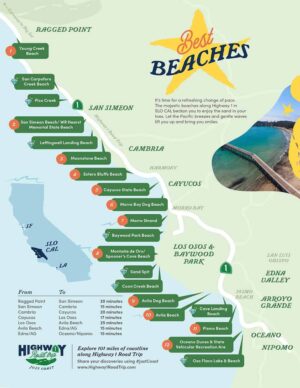From Eric Lindberg at AAA Colorado
For many travelers, the stretch of California halfway between Los Angeles and San Francisco is merely a drive-through gas stop. But just off Highway 101, rolling hills of vineyards that produce some of the state’s best wines descend toward the coast, where a string of small seaside towns feels far from the urban sprawl to the north and south. Although by no means undiscovered, this low-key, off-the-beaten-path area hints at a slower California from an earlier era. And with short distances between places, drive times pass quickly.

Day 1: Los Osos to Cayucos
My journey begins in Los Osos. Having spent the previous night surrounded by orchards and flower gardens at Bee’s Knees Fruit Farm, I set out early for the short drive southwest to Montaña de Oro State Park, a California seaside gem. More than 800 acres of coastal hills and beaches protect a wild ecosystem of crashing waves and rocky coastline. As I walk the Bluff Trail, a gentle hike following the curving shoreline, flycatchers, sparrows, and thrashers flit and sing along the path.
Within two hours, I’ve spotted more than 15 sea otters floating and diving in the offshore kelp beds. Standing on a bluff above the Pacific and looking 200 yards out to sea, I watch a humpback whale, then a second one, surface and submerge. Several coyotes serenade me from the nearby hills. Back in the trees a great horned owl hoots. With no sign of civilization, except for the trail I’m on, this seascape feels unchanged from a century ago.
Leaving the park, I drive just north of Cayucos, and by mid-morning I find myself knee-deep in the Pacific Ocean. As the cool ocean water swirls around my ankles, five of us forage for seaweed in the tidal zone below Estero Bluffs, just north of Cayucos. Spencer Marley, of Marley Family Seaweeds, is passionate about seaweed. Today we’re looking for lunch.
“Don’t worry; there are no toxic seaweeds. We can eat everything we find today.” Spencer radiates confidence, but the mounds of glistening vegetation at my feet look about as edible as the sand they’re lying on. Careful not to overharvest, we gather stands of seaweed washed up by the tide, occasionally picking up small pieces off rocks in deeper water.
Firing up a camp stove on the beach, Spencer offers cooking tips while he makes a broth with onion, garlic, soy sauce, and several seaweed varieties. “Never wash your seaweed in fresh water; it’ll turn to mush. Always use salt water,” he advises. Adding ramen, he creates a savory soup, and within minutes we’re settled on rocks and enjoying delicious noodle bowls at water’s edge. In that moment, I become a seaweed convert.
Returning to Cayucos, I check into On The Beach B&B, a friendly, oceanfront boutique hotel where I can hear the waves and see the pier from my room. Downtown is compact and walkable, and I spend a pleasant hour perusing the two-block stretch of beachy shops and cafés along N. Ocean Ave.
My seaweed friend Spencer has insisted I stop for fish and shrimp tacos at Ruddell’s Smokehouse. Joining the line, I order two tacos: salmon and tuna. The tacos are superb, and I savor them on the beach while watching surfers by the pier. Dessert is a seriously delicious cookie from Brown Butter Cookie Company, the big pink building just around the corner.
That afternoon I return to the ocean and wander the grassland marine terrace along the 4-mile (one way) Estero Bluffs trail just north of town. Pelicans patrol overhead; waves smash on the pebbly beach below. By the time the sun sets over the Pacific, I’ve seen nine otters and a handful of seals among the kelp beds.
Famished after hiking, I walk from my B&B to Schooners and enjoy fresh red snapper on the upstairs patio overlooking the ocean. It’s a two-minute walk back to the B&B, and I open the sliding door to my upstairs room and am lulled into sleep by the shushing of the waves below.

Day 2: Cambria
Early the next morning, I drive north on U.S. Hwy 1. and turn off just south of Cambria. A winding road takes me high into the hills above town to a clearing where seven Clydesdale horses wait at a hitching post. Tara Covell’s family owns Covell’s Clydesdales, and for the next two hours, Tara will lead me and five other riders upcountry on these gentle giants. The ride is smooth as we climb though oak forests and grassy meadows. Thirty-five minutes later we’re high on a ridge, rewarded with sweeping views of ranchland and the Pacific Ocean sparkling far below.
I head back to Cambria, and recharge with a latte at Lily’s Coffee House and then spend the morning browsing the eclectic art galleries and shops of East and West Villages. My lunch stop is Linn’s, a Cambria must, and AAA Three Diamond-designated restaurant. The food is good, but their olallieberry pie is what put Linn’s on the map. A cross between youngberry and loganberry, similar to a blackberry, it’s the perfect mix of sweet and tart. I leave with two jars of the jam.
The wines of San Luis Obispo County easily rival those of other California wine regions. Stolo Family Vineyards is nestled in a quiet valley a few minutes from Cambria, where the cool coastal climate creates different growing conditions from the hotter Paso Robles region just inland. Specializing in Pinot Noir and Syrah wines, their grapes grow on a steep hillside next to the tasting room. Relaxing in the garden, my first taste of local wine is a refreshing rose of Pinot Noir, a charming introduction to the county’s wines.
While in Cambria, I’m staying in a cottage at the AAA Three Diamond-designated Oceanpoint Ranch, north of town. From here, it’s a two-minute walk to the upper end of the mile-long Moonstone Beach Boardwalk that hugs the bluffs above the shoreline. That afternoon I join locals and tourists out for a sunset saunter in the tangy ocean breeze. It’s tamer here than my previous coastal walks but no less scenic. Side trails lead down to beaches and pocket coves where kids fly kites and surfers ride waist-high waves at several beach breaks.
After sunset, I dine on the outdoor patio at the AAA Three Diamond-designated Robin’s Restaurant, a food highlight of my trip. With delicious global cuisine ranging from Tandoori chicken and steak to Skuna Bay salmon, lasagna, and North Indian lamb curry, and with superb salads, the decision isn’t easy. Starting with salmon bisque, I move on to shrimp enchiladas with mole sauce. After a brief, internal “should I” debate, I finish with what’s easily one of the best carrot cakes I’ve ever tasted. I highly recommend making reservations, though.

Day 3: Wine Region
The next day, I head north on U.S. Hwy 1 toward San Simeon, pulling out at Piedras Blancas Elephant Seal Rookery, where thousands of elephant seals are sprawled out on the sand. Stopping frequently along the long boardwalk above the beach, I watch them bellow, squabble, and hump their way across the sand. Enormous and often comical, their numbers depend on the season. January, February, and October to May are busy times, but there are seals on the beach throughout the year.
One of this coast’s major draws is Hearst Castle, but unfortunately, it’s currently closed due to COVID concerns. So instead, I stop by Hearst Ranch Winery, down the hill from the castle, to sample their wine. Perched high on a cliff overlooking San Simeon Bay, the winery’s tasting area under the trees offers spectacular views of the pier and Pacific Ocean. I sample delicious Chardonnay, Petite Sirah, and Zinfandel paired with a cheese and charcuterie plate. After tasting, I park my car at the beachside lot below, follow the bay along water’s edge, and take the San Simeon Cove Trail through groves of eucalyptus and Monterey cypress bearded with Spanish moss and creaking in the breeze. The easy trail ends at San Simeon Point, a wild, windy peninsula where I cinch my hat strap and watch two otters floating amid the kelp beds below.
Leaving the coast, I turn inland through the hills to Paso Robles, my base for exploring the local wine region. Set on a hillside in a valley west of town, Kukkula Winery is an organic, non-irrigated vineyard with terroir similar to the Rhone region of France. Owner Kevin Jussila is passionate about his land and the resulting wines. “We believe if we’ve farmed well, there’s little need to intervene in the cellar,” he says. The resulting Cabernet Sauvignon, Syrah, Grenache, Viognier, and other varietals and delightful blends offer intense flavors reminiscent of Rhone wines.
Up a nearby valley is Sixmilebridge Winery. Here, the steep hillsides produce several Bordeaux varietal grapes grown amid a thick limestone layer that dominates the terrain. Seated on their tasting deck at the base of the vineyards, I sample various blends of Malbec, Zinfandel, Cabernet, Merlot, and Petit Verdot. Perhaps it’s the surrounding serenity that biases my palate, but each wine seems infused with flavors born of these rugged hills.
With quality wine comes local good food. The culinary scene in Paso Robles (Paso to locals) is thriving, supported by boutique businesses, such as Kiler Ridge Olive Oil. Spread over 15 acres southwest of town, and producing small-batch olive oil from seven different varietals, Kiler Ridge produces the kind of flavorful olive oil found on gourmet food shelves. Relaxing on their patio overlooking the groves, I taste five oils and discover the dramatic differences between these and the lower quality, mass-marketed oils. After tasting both types, I can’t imagine returning to the cheap stuff.
For my last night, I stay at The Stables Inn, a retro boutique motel three blocks from the town center. In the evening, guests socialize safely at a communal outdoor fire pit. I head to the downtown entertainment district of brewpubs, restaurants, and bars. One of the locals recommends Thomas Hill Organics for dinner. Their creative, locally sourced cuisine (braised beef empanadas and saffron fettuccini!) and unique wine selection make Thomas Hill an easy Paso choice.
I end my trip on a dreamlike note by taking in Sensorio, an art installation of almost 60,000 lights set in the low hills east of Paso. As dusk approaches, a surreal sea of colors undulates and changes amid a rolling topography of oak trees silhouetted in the purpling light. Starting first from a raised viewing terrace, I stroll the winding path among hills shimmering with light. The colors intensify as the last light fades from the sky. Sensorio is an enchanting illumination of geography and a fitting end to my journey through this classic California landscape.
Read the full article on AAA.


